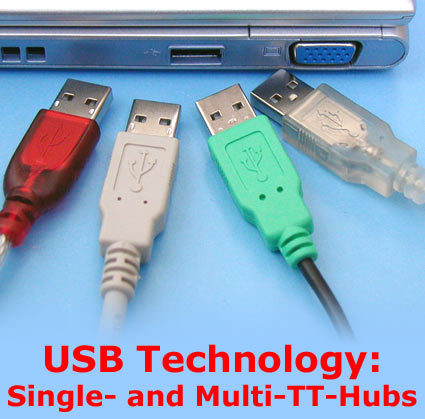USB Technology: Multi-TT Hub Goes Head-to-Head With Single-TT
The Hub Hubbub: Intelligent Vs. Conventional USB 2.0 Hubs
USB has been a common standard for several years now. Unfortunately, many people mistakenly believe that USB 2.0 has made poor performance a thing of the past. The naked truth is that USB 2.0 devices can churn through data in no time, and USB 1.1 devices can be optimally interfaced with PCs only if they are not connected through a USB hub.
Time and time again, users have been stopped dead in their tracks because their USB 1.1 hubs only have a bandwidth of 12 mbit/s that has to be distributed among all their devices. You would think that the solution ought to be simple - just switch to USB 2.0, which offers 480 mbit/s - and there you have it: several slow devices running at an acceptable speed. Right?
Not really. Not all hubs use the same method to insert the 12 mbit/s signals into the 480 mbit/s data stream. The insertion is the responsibility of special units in the USB hubs called transaction translators, or TTs for short. The TTs can't work with several devices simultaneously, which creates the bottleneck you bump up against whenever you connect several USB 1.1 devices at once.
We received a hub with multiple TTs from Cypress Semiconductor, a major manufacturer of this type of component, and put it up against a conventional hub with a single TT in a test that simulates real-world conditions.
Get Tom's Hardware's best news and in-depth reviews, straight to your inbox.
Current page: The Hub Hubbub: Intelligent Vs. Conventional USB 2.0 Hubs
Next Page Universal Serial Bus: ABC
Patrick Schmid was the editor-in-chief for Tom's Hardware from 2005 to 2006. He wrote numerous articles on a wide range of hardware topics, including storage, CPUs, and system builds.
-
I am having a really hard time resolving this issue on a brand new Asus desktop machine with the Asus motherboard P8H61-MX. It seems that Asus have cut a corner or two and only included a single TT setup on the motherboard which has 6 inbuilt USB ports. I am having real difficulty finding a PCI express USB card here in the UK which actually has a built in Multi TT setup. My Novation NIO 2|4 soundcard and my Vestax VCI-100 midi controller fail to function without multi TT, and if anyone has any advice it would be appreciated.Reply
David
